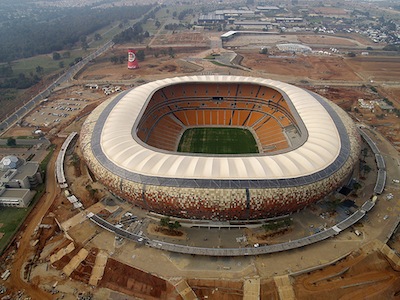[Part 3 of a 3 part series. Read part 1 and part 2. Author Eli Jelly-Schapiro will also be blogging from the Cup. Read his most recent entries here.]
Fifteen years after the new South Africa’s first democratic elections, the dream of a true, non-racial, economically just “Rainbow Nation” endures. But so too do the inequalities of race and class that are the legacy of apartheid and its colonialist antecedents. In April of 2009 Jacob Zuma, inheritor of the African National Congress (ANC) leadership and anointed restorer of the liberationist mantle, rode a wave of populist energy to the national presidency. His ascension, however, has not quelled a resurgence of social unrest, expressed in township demonstrations against government neglect and in trade union actions — of which several have disrupted World Cup preparations — against depressed wages and rising food and energy costs. For the majority of South Africans who retain faith in the nation’s potential — and the global import of its universalist ideals — but mourn the violent inequities that continue to shape daily life in apartheid’s aftermath, the World Cup is cause for a difficult if needed national reckoning. How to gesture to the world with cosmopolitan conviction, while not eliding the social fracture the nation itself is yet to overcome?
Labor organizer George Ledwaba, with whom I recently spoke beside the pool at a stylish hotel on the outskirts of the northeastern city of Nelspruit, insisted that South Africa’s local and global concerns are necessarily entwined. The movement for less violent social relations at home and the aspiration for greater respect and fuller membership in the global community are allied struggles. “We believe,” he emphasized, “that the two processes can come together.” The “Afro-pessimist” chorus, vocal within and beyond South Africa, suggests otherwise: rampant crime and political corruption are evidence of an “immature” governing class. A recent spate of “xenophobic” attacks — perpetrated by residents of South Africa’s poorest communities against economic migrants from neighboring countries — is proof that the ideal of the “Rainbow Nation” is a naive fantasy. And the political violence that marred this year’s African Cup of Nations in Angola casts serious doubt on the readiness of any African country to host an event of the World Cup’s magnitude. Ledwaba dismissed this pessimistic narrative as simply the latest expression of that old colonialist perception “of Africa as a whole as the dark continent. . . . [Western countries] are not ready to accept that it is our time and we are quite capable.”1
Apprehension over the form of Bafana Bafana, in other words, is fueled by anxiety over the precarious present and uncertain future faced by the new South Africa and the continent for which it stands. In several weeks’ time the world will descend on South Africa to watch their football heroes bandy a ball about under the colors of their national flags and the omnipresent signs of the tournament’s official sponsors. One semi-final will unfold in Cape Town, the other in Durban. The final will take place in Johannesburg, on the edge of Soweto, in a magnificently refurbished stadium designed to evoke an African calabash pot — a blown-up version of the ceramic wares on offer in Greenmarket Square. Ninety-five thousand people will witness the match in person, while perhaps a billion more across the planet–including tens of thousands living in shantytowns in the stadium’s shadow, for whom the cost of a match ticket is out of reach — will watch on television, huddled together in bars and shops, homes and public squares, anticipating, with no bad faith, the miraculous.


